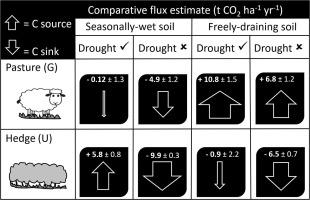Our official English website, www.x-mol.net, welcomes your
feedback! (Note: you will need to create a separate account there.)
Hedgerow effects on CO2 emissions are regulated by soil type and season: Implications for carbon flux dynamics in livestock-grazed pasture
Geoderma ( IF 5.6 ) Pub Date : 2021-01-01 , DOI: 10.1016/j.geoderma.2020.114697 Hilary Ford , John R. Healey , Bid Webb , Tim F. Pagella , Andrew R. Smith
Geoderma ( IF 5.6 ) Pub Date : 2021-01-01 , DOI: 10.1016/j.geoderma.2020.114697 Hilary Ford , John R. Healey , Bid Webb , Tim F. Pagella , Andrew R. Smith

|
Abstract In this study we assess the potential for farmland hedgerows to provide climate mitigation via carbon (C) storage, using soil carbon dioxide (CO2) efflux to improve upscaling validity. Two contrasting sites, freely-draining (FD) versus seasonally-wet (SW), situated in mixed-livestock farms (Conwy, Wales, UK), were selected. We measured soil CO2 efflux associated with three field boundaries: hedgerow on SW soil; hedgerow on FD soil; stone wall (abiotic control) on FD soil, quantifying the influence of distance from field boundary and grazing occurrence (grazed pasture versus un-grazed zone adjacent to hedgerows) on annual C budgets based on soil CO2 flux and net primary productivity. For the FD site, the annual C budget showed that pasture was a net source of C emissions (11 ± 1.5 t CO2 ha−1 yr−1) and the un-grazed zone adjacent to the hedgerow a net sink (-0.9 ± 2.2 t CO2 ha−1 yr−1). For the SW site, pasture acted as a small net sink of C (-0.1 ± 1.3 t CO2 ha−1 yr−1) and the hedgerow zone a net source (5.8 ± 0.8 t CO2 ha−1 yr−1), due entirely to a spike in soil CO2 efflux associated with a relatively unusual summer drought. To investigate the effect of this observed summer drought on more typical (for the UK maritime climate) annual C source-sink dynamics, we modelled soil CO2 efflux for a summer-drought-excluded year for both FD and SW soils. With greater hedgerow cover (modelled prediction compared with a baseline of no hedgerows), annual CO2 flux became more negative (greater net sink) in fields on FD soil (by 1 t CO2 ha−1 yr−1 at 8% hedgerow cover), with drought limiting the effect size. In SW soils, greater hedgerow cover also led to a more negative annual CO2 flux (by 0.4 t CO2 ha−1 yr−1 at 8% hedgerow cover) when drought was excluded, but a more positive flux (net C source) with drought included (by 0.5 t CO2 ha−1 yr−1 at 8% hedgerow cover). This study illustrates the importance of the interaction between soil type and seasonal events such as drought on the ability of hedgerows to act as a net C sink.
中文翻译:

绿篱对二氧化碳排放的影响受土壤类型和季节的调节:对放牧牧场碳通量动态的影响
摘要 在这项研究中,我们评估了农田绿篱通过碳 (C) 储存提供气候缓解的潜力,使用土壤二氧化碳 (CO2) 流出来提高放大有效性。选择了位于混合养殖场(康威,威尔士,英国)的两个对比鲜明的地点,自由排水 (FD) 与季节性湿润 (SW)。我们测量了与三个田间边界相关的土壤 CO2 流出:西南土壤上的树篱;FD 土壤上的树篱;FD 土壤上的石墙(非生物控制),基于土壤 CO2 通量和净初级生产力,量化与田间边界的距离和放牧发生(放牧牧场与靠近树篱的未放牧区)对年度碳预算的影响。对于 FD 场地,年度碳预算显示牧场是碳排放的净来源 (11 ± 1. 5 t CO2 ha-1 yr-1) 和与树篱相邻的未放牧区净汇 (-0.9 ± 2.2 t CO2 ha-1 yr-1)。对于 SW 站点,牧场作为 C 的一个小净汇(-0.1 ± 1.3 t CO2 ha−1 yr−1),而绿篱区作为净源(5.8 ± 0.8 t CO2 ha−1 yr−1)完全是由于与相对不寻常的夏季干旱相关的土壤 CO2 流出量激增。为了研究观察到的夏季干旱对更典型(对于英国海洋气候)年度 C 源汇动态的影响,我们模拟了 FD 和 SW 土壤在夏季排除干旱的年份的土壤 CO2 流出。随着树篱覆盖率的增加(模型预测与没有树篱的基线相比),FD 土壤上田间的年 CO2 通量变得更加负(更大的净汇)(在 8% 的树篱覆盖率下,1 t CO2 ha−1 yr−1),干旱限制了影响的大小。在 SW 土壤中,当排除干旱时,更大的树篱覆盖也导致更负的年度 CO2 通量(0.4 t CO2 ha-1 yr-1,8% 的树篱覆盖),但包括干旱在内的更正通量(净碳源)(0.5 t CO2 ha−1 yr−1,树篱覆盖率为 8%)。本研究说明了土壤类型与干旱等季节性事件之间的相互作用对绿篱作为净碳汇的能力的重要性。
更新日期:2021-01-01
中文翻译:

绿篱对二氧化碳排放的影响受土壤类型和季节的调节:对放牧牧场碳通量动态的影响
摘要 在这项研究中,我们评估了农田绿篱通过碳 (C) 储存提供气候缓解的潜力,使用土壤二氧化碳 (CO2) 流出来提高放大有效性。选择了位于混合养殖场(康威,威尔士,英国)的两个对比鲜明的地点,自由排水 (FD) 与季节性湿润 (SW)。我们测量了与三个田间边界相关的土壤 CO2 流出:西南土壤上的树篱;FD 土壤上的树篱;FD 土壤上的石墙(非生物控制),基于土壤 CO2 通量和净初级生产力,量化与田间边界的距离和放牧发生(放牧牧场与靠近树篱的未放牧区)对年度碳预算的影响。对于 FD 场地,年度碳预算显示牧场是碳排放的净来源 (11 ± 1. 5 t CO2 ha-1 yr-1) 和与树篱相邻的未放牧区净汇 (-0.9 ± 2.2 t CO2 ha-1 yr-1)。对于 SW 站点,牧场作为 C 的一个小净汇(-0.1 ± 1.3 t CO2 ha−1 yr−1),而绿篱区作为净源(5.8 ± 0.8 t CO2 ha−1 yr−1)完全是由于与相对不寻常的夏季干旱相关的土壤 CO2 流出量激增。为了研究观察到的夏季干旱对更典型(对于英国海洋气候)年度 C 源汇动态的影响,我们模拟了 FD 和 SW 土壤在夏季排除干旱的年份的土壤 CO2 流出。随着树篱覆盖率的增加(模型预测与没有树篱的基线相比),FD 土壤上田间的年 CO2 通量变得更加负(更大的净汇)(在 8% 的树篱覆盖率下,1 t CO2 ha−1 yr−1),干旱限制了影响的大小。在 SW 土壤中,当排除干旱时,更大的树篱覆盖也导致更负的年度 CO2 通量(0.4 t CO2 ha-1 yr-1,8% 的树篱覆盖),但包括干旱在内的更正通量(净碳源)(0.5 t CO2 ha−1 yr−1,树篱覆盖率为 8%)。本研究说明了土壤类型与干旱等季节性事件之间的相互作用对绿篱作为净碳汇的能力的重要性。











































 京公网安备 11010802027423号
京公网安备 11010802027423号